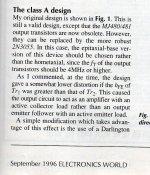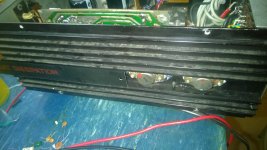In its present form, this circuit would be good for a bunch of blown power supply fuses...
Please elaborate with some arguments.

In its present form, this circuit would be good for a bunch of blown power supply fuses...
No arguments presented for upper statement? Bunch of crrrap?



Case closed.


I just completed building the Quasi Nbip300 amp Nbip300 - Quasi's DIY Audio Site
and used 4 transistors 2n3055 to test the circuit running at 30-0-30 supply transformer and the AMP worked great!!! I could have added 2 more pairs but this was just a test to see if the board I made would work.
The 2n3055 had WONDERFUL base, it was really solid and seemed to give me a "soft" clip when pushed to the limit. I really liked the attributes to the 2n3055 for something like a subwoofer amp it was such a classic PA sub sound that I really enjoyed.
Next I swapped out the transistors for 4 pairs of MJ15024 and I lost that really cool base sound.
I would suggest building a Nbip amp with leftover 2n3055, its a great circuit, easy to build, and tested to work great by many builders here on the form. If you have the H version of the tranny then you can power with more voltage otherwise you will have to use 30-40 volts in. By using 4 pair of 2n3055 you could use a higher supply current and reduce your speaker to 4 ohms to achieve more power out.
Again I really liked the classic sound and feel that lots of young builders could get a lot out of building an amp with 2n3055.
and used 4 transistors 2n3055 to test the circuit running at 30-0-30 supply transformer and the AMP worked great!!! I could have added 2 more pairs but this was just a test to see if the board I made would work.
The 2n3055 had WONDERFUL base, it was really solid and seemed to give me a "soft" clip when pushed to the limit. I really liked the attributes to the 2n3055 for something like a subwoofer amp it was such a classic PA sub sound that I really enjoyed.
Next I swapped out the transistors for 4 pairs of MJ15024 and I lost that really cool base sound.
I would suggest building a Nbip amp with leftover 2n3055, its a great circuit, easy to build, and tested to work great by many builders here on the form. If you have the H version of the tranny then you can power with more voltage otherwise you will have to use 30-40 volts in. By using 4 pair of 2n3055 you could use a higher supply current and reduce your speaker to 4 ohms to achieve more power out.
Again I really liked the classic sound and feel that lots of young builders could get a lot out of building an amp with 2n3055.
I just completed building the Quasi Nbip300 amp Nbip300 - Quasi's DIY Audio Site
and used 4 transistors 2n3055 to test the circuit running at 30-0-30 supply transformer and the AMP worked great!!! I could have added 2 more pairs but this was just a test to see if the board I made would work.
The 2n3055 had WONDERFUL base, it was really solid and seemed to give me a "soft" clip when pushed to the limit. I really liked the attributes to the 2n3055 for something like a subwoofer amp it was such a classic PA sub sound that I really enjoyed.
Next I swapped out the transistors for 4 pairs of MJ15024 and I lost that really cool base sound.
I would suggest building a Nbip amp with leftover 2n3055, its a great circuit, easy to build, and tested to work great by many builders here on the form. If you have the H version of the tranny then you can power with more voltage otherwise you will have to use 30-40 volts in. By using 4 pair of 2n3055 you could use a higher supply current and reduce your speaker to 4 ohms to achieve more power out.
Again I really liked the classic sound and feel that lots of young builders could get a lot out of building an amp with 2n3055.
In the PA gigs and when sound engineers meet for the first time with the band and while sound check the musicians will ask things always starting with the word ADD ...example: add a bit of high ...add a bit of bass ...add a bit of middle....and always add a bit of power ....
now if you fall into the trap and start increasing high and low and volume for the guitar player eventually the keyboard player will ask for more ...then the drummer will ask for more and you will end up producing all your SPL from the monitors.
The trick is to translate the language of the musician to a sound engineer language ...example : Musician : could you add a bit of bass ? ( dont look for the word please in the sentence.Please dont exist in musician language ) Sound engineer : ( first decrease 1-3db of high and 2-4db of middle ) IS THAT OK NOW ???
In your case MJ's was probably faster responding far better in high frequency ( taking in mind that the particular circuit responds very nicelly in high frequencies ) resulting a more linear result rather than a "bassy" one that was created form the dead slow 2N3055 transistor
nice eeee?

Last edited:
Maplin 225WRMS picture.
Here is a stereo setup.
These are like hens teeth to get hold of now.
I gave up at £90 for one on ebay last year.
Here is a stereo setup.
These are like hens teeth to get hold of now.
I gave up at £90 for one on ebay last year.
An externally hosted image should be here but it was not working when we last tested it.
Here is some more info on Maplin 225WRMS amplifier.
I recently got hold of a pair of none working Maplin amplifiers and got both working.
Out of interest I put the output transistors on a semiconductor analyser and the VCE breakdown was 120 volts.
http://www.ckp-railways.talktalk.net/maplin225.htm
I recently got hold of a pair of none working Maplin amplifiers and got both working.
Out of interest I put the output transistors on a semiconductor analyser and the VCE breakdown was 120 volts.
http://www.ckp-railways.talktalk.net/maplin225.htm
Mr east electronics, the latest generation 2N3055's are not dead slow but typically 3MHz.
Unless someone was unlucky enough to obtain original RCA hometaxial types ...
I got caught out by the upgrade to 3mhz.
I bought a couple of 1980's amplifiers with MJ2955/2N3055's on the outputs.
The output transistors were missing so I bought some brand new ones off RS Components.
The amplifier worked at low levels but would start to click and make noises at higher power levels. On the scope I could see massive oscillation on the output. So I increased the VAS capacitor a bit and it all calmed down.
I had forgotten how good they sounded.
H = hometaxial. The original process used for making older power transistors like the 2N3055. I remember JLH mentioning this in Wireless World in one of his JLH69 update articles.
I found this on the forum which supports the above,
http://www.diyaudio.com/forums/solid-state/32694-simple-stereo-amp-aroud-2n3773-2.html#post2581923
I agree that they are probably nothing like the original devices though.
I found this on the forum which supports the above,
http://www.diyaudio.com/forums/solid-state/32694-simple-stereo-amp-aroud-2n3773-2.html#post2581923
I agree that they are probably nothing like the original devices though.
I just finish a restoration of an amplifier from early 80´s which uses two pairs of 2N3055C from RCA. all the output transistors are originals and they were in good condition.
52Vcc symmetrical power supply dropped to 46V under full 4 ohms load.
One channel driven: aprox. 160W continuous at 1kHz during a long period of time, just before clipping condition.
The heatsink reached more than 60 degrees Celsius... but nothing exploded and the thing worked well...


I didn´t find any information about this "C" variant of RCA2N3055. But the amp is very old and it was working before the restoration, normally.
Best regards,
52Vcc symmetrical power supply dropped to 46V under full 4 ohms load.
One channel driven: aprox. 160W continuous at 1kHz during a long period of time, just before clipping condition.
The heatsink reached more than 60 degrees Celsius... but nothing exploded and the thing worked well...
I didn´t find any information about this "C" variant of RCA2N3055. But the amp is very old and it was working before the restoration, normally.
Best regards,
Attachments
Interesting ... looks as though the transistors aren't identical but presumably selected because of the red and blue dots painted on. Also, they are not marked "2N3055" but just "3055". I suspect these are the epitaxial versions (One transistor seems to be "3055E" not "C") - and possibly selected for 100V.
I have mentioned in an earlier post that to meet the 100V BVcbo of the hometaxial transistor, most epi transistors had to have 100V BVceo due to the more abrupt breakdown. I dare not test my obsolete RCA epi's because they sometimes show "walk-down" breakdown. I have not seen this in ST nor ON Semi devices, and most of those I have had have worked to over 100V.
SO maybe possible, but you would have to test the breakdown voltages.
John.
I have mentioned in an earlier post that to meet the 100V BVcbo of the hometaxial transistor, most epi transistors had to have 100V BVceo due to the more abrupt breakdown. I dare not test my obsolete RCA epi's because they sometimes show "walk-down" breakdown. I have not seen this in ST nor ON Semi devices, and most of those I have had have worked to over 100V.
SO maybe possible, but you would have to test the breakdown voltages.
John.
Interesting ... looks as though the transistors aren't identical but presumably selected because of the red and blue dots painted on. Also, they are not marked "2N3055" but just "3055". I suspect these are the epitaxial versions (One transistor seems to be "3055E" not "C") - and possibly selected for 100V.
I have mentioned in an earlier post that to meet the 100V BVcbo of the hometaxial transistor, most epi transistors had to have 100V BVceo due to the more abrupt breakdown. I dare not test my obsolete RCA epi's because they sometimes show "walk-down" breakdown. I have not seen this in ST nor ON Semi devices, and most of those I have had have worked to over 100V.
SO maybe possible, but you would have to test the breakdown voltages.
John.
Yes, I think they were selected at the factory. RCA had a plant in Brasil in the 70´s. Sometimes they made semiconductors labeling them with local codes, some of them using part codes for specific local audio manufacturers. That´s why, I suppose, I can´t find any information about them in the datasheet archives available on the Internet.
The 2N3055E is, I think, from different batch (and date) because the RCA logo is different too.
And I think these transistors passed easily in the test of the use and of the time, considering that they were working (hard) during the last 30 years... the power supply elcos were dried and for sure they had very bad times during their lives.
Regards,
- Status
- This old topic is closed. If you want to reopen this topic, contact a moderator using the "Report Post" button.
- Home
- Amplifiers
- Solid State
- 2n3055 amp claims 200 to 220 watt

